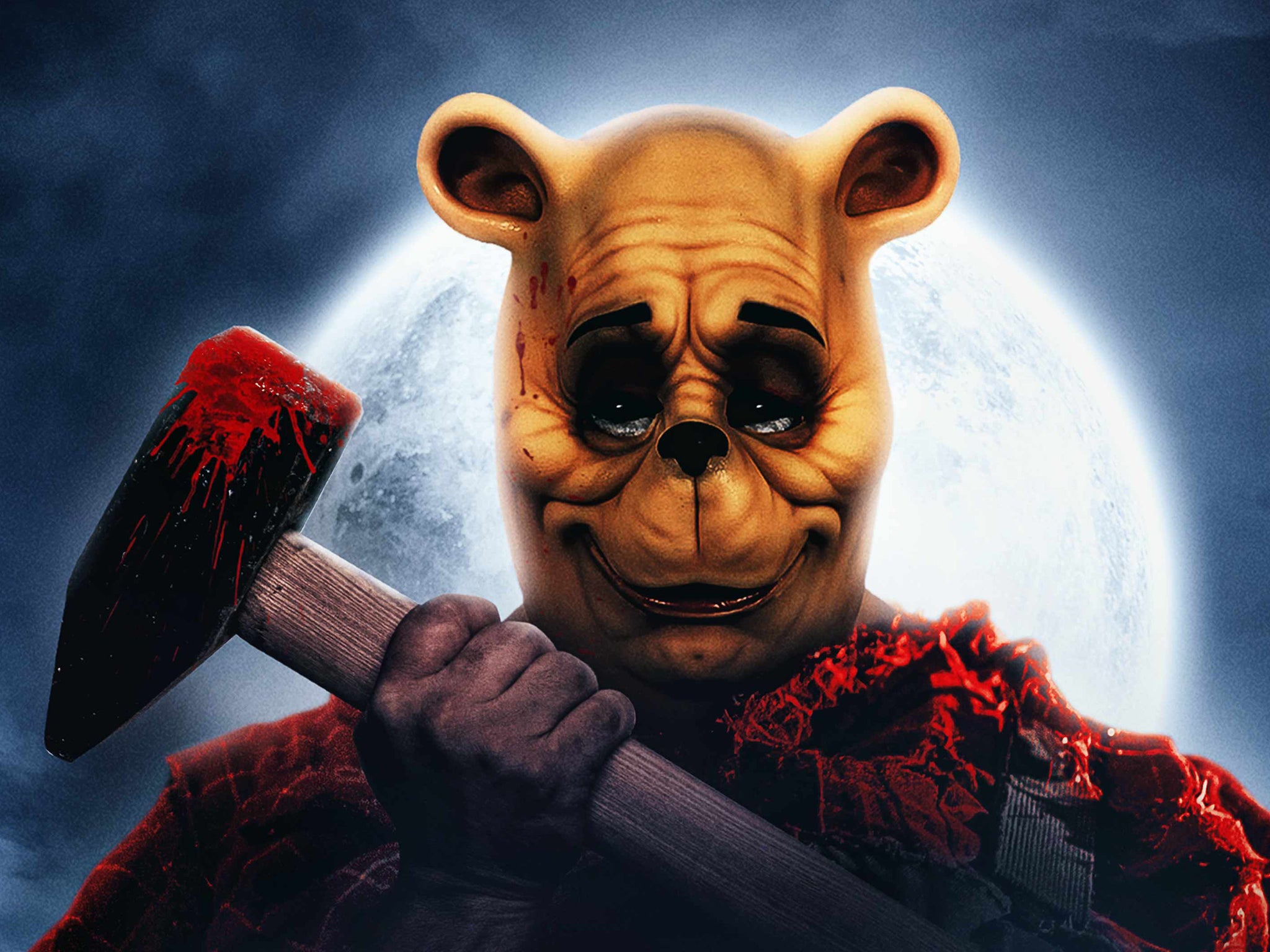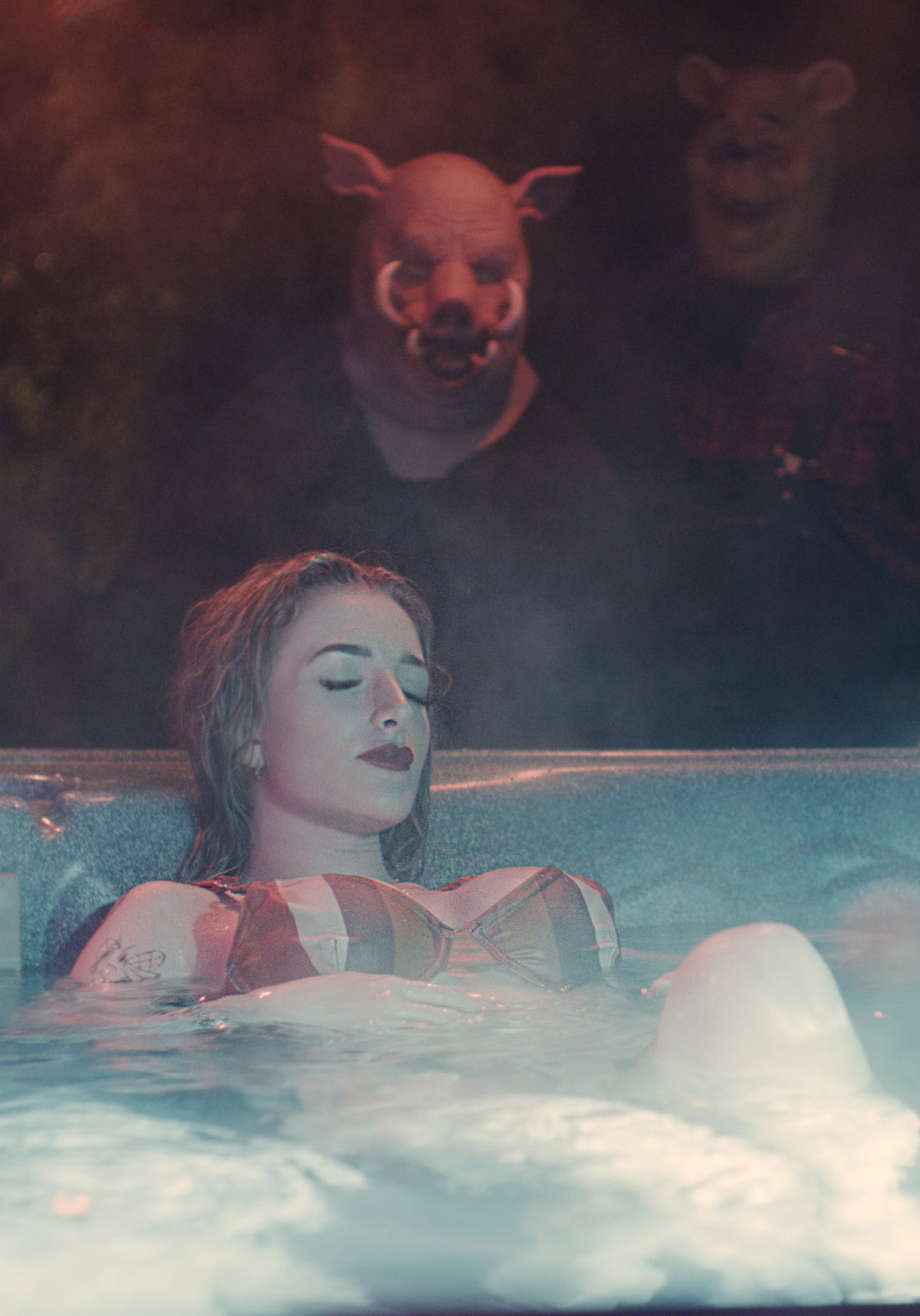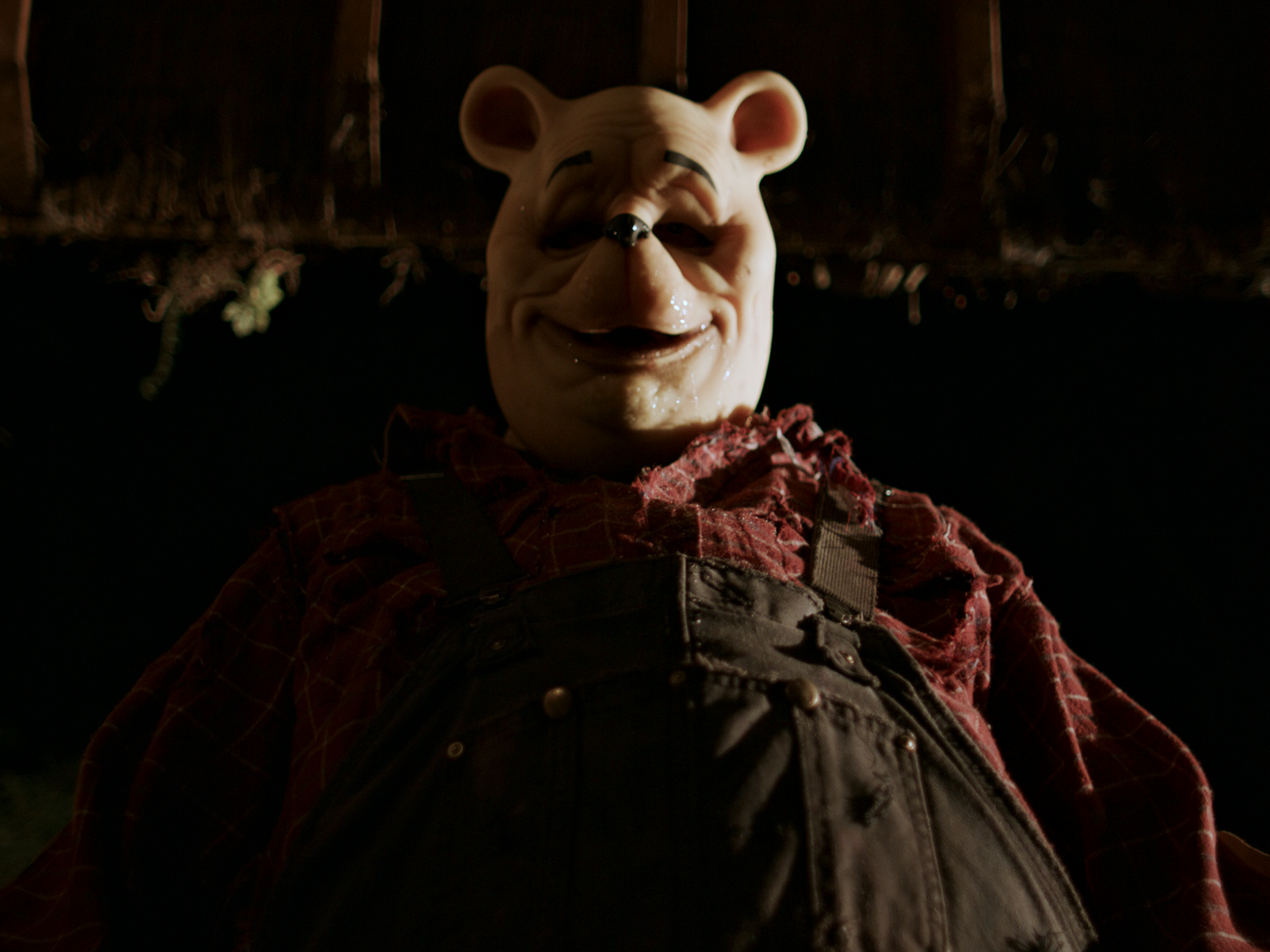‘I hope critics don’t think I’m being serious’: The mad genius behind the Winnie-the-Pooh slasher film
As the instantly viral slasher film ‘Winnie-the-Pooh: Blood and Honey’ is finally released, Chris Edwards meets the writer/director turning beloved intellectual property into grungy B-movies

When AA Milne first came up with the character of Winnie-the-Pooh, he probably never envisaged the loveable bear slitting the throats of four East Sussex truck drivers. It’s also unlikely that he ever imagined a scenario in which Piglet would bludgeon someone to death with a sledgehammer in a swimming pool. However, these are things that actually happen in Winnie-the-Pooh: Blood and Honey, the micro-budget slasher film that reimagines the creatures of the Hundred Acre Wood as cannibalistic freaks.
If that concept sounds utterly ridiculous, that’s because it is. From the design of Pooh to the fascinatingly ropey script and performances, this film really does produce bigger laughs than your average comedy. But according to writer-director Rhys Frake-Waterfield, it’s meant to. He points to a scene in which Pooh throws a decapitated head at a car, only for it to be swept away by the windscreen wipers. “That’s supposed to be funny and stupid,” he laughs, playing down the swathes of negative reviews that are just as (if not more) brutal than some of the deaths in his film.
Released in selected cinemas last week ahead of a VOD release on Monday, Blood and Honey has been universally slaughtered by critics. The Telegraph described it as “the most cretinous film” the publication is likely to cover this year, while The Guardian compared the experience of watching it to swallowing honey with arsenic. Other reviews have been similarly scathing about the directing, writing and acting. Frake-Waterfield, though, says he’s not taking any of it to heart. Calling via Zoom from his home in London, he actually seems to be giggling at the whole situation. He insists that he’s never taken himself nor his film too seriously – but it’s hard not to suspect that he’s a little bit annoyed by some of the things being said.
“It’s so stupid,” he says. “When I read some of the reviews, they’re like, ‘As if this happens or that happens,’ [or] ‘It was so stupid that she made that decision’. But that’s the fun of it! In horror films, people sometimes make stupid decisions. Characters are running from the villain and suddenly stumble over for no reason. I purposely tried to introduce those sorts of elements in the film.” He references a scene in which a woman is sat in a jacuzzi, clocks a deformed Pooh and Piglet in the background of one of her selfies, and then inexplicably goes straight back to relaxing. “I just thought it would be funny,” he laughs.
It’s difficult to gauge which bits of the film are meant to be intentionally funny, and which bits are just so bad that they end up being hysterical anyway. For instance, the aforementioned East Sussex truck drivers speak with an unexplained mix of southern American and Cockney accents. In another alarmingly horrible-slash-funny moment, Pooh and Piglet use blood to scrawl “get out” on a window, leading another character to astutely suggest that the killers “probably wrote that”.
Again, Frake-Waterfield insists that this was all part of the fun. With a cheeky glint in his eye, he says: “Cult classic-y films like this, sometimes they just don’t take themselves too seriously, and that’s what I really wanted to do with this. I wanted it to be a film that when you watch it with a large audience, everyone embraces the camp.”
When some critics try to be mean-spirited, you’ve just got to ignore them
Blood and Honey became a possibility at the beginning of 2022, when the copyright expired on Milne’s 1926 Winnie-the-Pooh debut, meaning absolutely anyone could swoop in and play around with the material. Frake-Waterfield – a former EDF Energy employee who moved into the film business just two years ago – was searching for a horror concept at the time, and when he noticed that this particular intellectual property was up for grabs, he pounced on the opportunity like a feral critter.
His idea for the film’s plot was a novel one. Having departed for university years ago, an adult Christopher Robin returns to the Hundred Acre Wood. There he discovers that his once-domesticated friends, Pooh and Piglet, have turned into bloodthirsty killers after being abandoned by him. They now torture, slaughter and eat anyone who crosses their path – but mostly women. (Understandably, one of the common criticisms of the film has been that it revels in violent misogyny – and considering Pooh needlessly pulls off one victim’s top before feeding her into a wood chipper, it’s hard to disagree.)
With a budget of just £20,000, Frake-Waterfield knew his film wouldn’t be the next Halloween Kills or The Texas Chainsaw Massacre – two titles he cites as major influences. He didn’t have free rein either, with only specific elements of Milne’s original book able to be used and abused – Disney’s later interpretation of Milne’s work wasn’t. That meant Pooh’s trademark red shirt, his voice, the catchphrase “Oh bother” and even the character Tigger – who wasn’t introduced by Milne until 1928 – were all off the table.

Watch Apple TV+ free for 7 day
New subscribers only. £9.99/mo. after free trial. Plan auto-renews until cancelled.
ADVERTISEMENT. If you sign up to this service we will earn commission. This revenue helps to fund journalism across The Independent.

Watch Apple TV+ free for 7 day
New subscribers only. £9.99/mo. after free trial. Plan auto-renews until cancelled.
ADVERTISEMENT. If you sign up to this service we will earn commission. This revenue helps to fund journalism across The Independent.
Frake-Waterfield subsequently had to conjure up a whole new look for Pooh, which, considering the film was operating on a basically non-existent budget, ended up being a heavily-built man (actor Craig David Dowsett) in a motionless rubber mask and Marigold gloves. A 2ft VFX bear was initially considered, but budget and time constraints, as well as concerns about the character’s physicality, ultimately forced the film in a different direction.

Frake-Waterfield knew that those constraints would drastically affect the quality of the film, but also that this wouldn’t be taken into consideration by critics. “They’re going to expect a multimillion-pound film,” he says. “Something the size of Cocaine Bear’s £30m [budget]. Horror is not really a genre they rate well, anyway. There are certain kinds of expectations and tropes you need to lean into with horror and they often just don’t like that. So not only do we have the genre against us, we also have the budget and everything else against us. You’ve got to be super thick-skinned for this. When some [critics] try to be mean-spirited, you’ve just got to ignore them.”
In any case, the cheaper anthropomorphic designs for Pooh and Piglet opened up more gruesome and silly possibilities. With hands and thumbs, they could now hold things like machetes and chains and sledgehammers. In one scene, Pooh even gets behind the wheel of a car and slowly drives over the head of one of his helpless victims, popping it like a particularly juicy grape. “I hope no critic thinks I’m being dead serious when I’ve got Pooh driving a car,” Frake-Waterfield laughs. “There are loads of moments in the film where, hopefully, [people] realise I’m not being dead serious.”
But it’s not just the critics he’s had to contend with. When stills of the film went viral last year, horror fans were immediately divided. While many were excited by the mere sight of an axe-wielding half-man, half-bear, others were outraged. Petitions sprung up against the film’s release and Frake-Waterfield received near-daily death threats. He still does. One person, whose fond childhood memories of Winnie-the-Pooh had presumably been tainted, wrote to him: “You son of a bitch. I’m going to kill you, you dirty bag of s***!”
The combined discourse served as a free form of marketing, though. The film has since gone on to screen at cinemas all over the world, and is currently on course to record a $6m (£4.9m) haul at the global box office, easily making it one of the most profitable films of the year. It’s for that reason that a bigger-budget sequel (10 times larger, in fact) has already been thrust into production. Frake-Waterfield is also set to work on further reimaginings of classic IP, including Bambi: The Reckoning and Peter Pan’s Neverland Nightmare.

Regardless of what critics think, Frake-Waterfield believes the buzz around his film and its subsequent box office success demonstrates that his faith in the project was justified. “I loved seeing this concept I believed in have this degree of expansion in the market and this viral nature to it,” he says. And could this be the future of low-budget filmmaking? Transforming quaint, copyright-free IP into grungy horror and then watching as it generates Twitter chatter and ticket sales? Maybe. It’s also tricky to know how to feel about it. On the one hand, it’s cynical and depressing. On the other, it’s kind of hilarious. But if there’s anyone who’s really laughing, it’s the guy who’s just made a multimillion-pound success thanks to a Halloween mask and a pair of washing-up gloves.
‘Winnie-the-Pooh: Blood and Honey’ is available to rent and buy from 20 March
Join our commenting forum
Join thought-provoking conversations, follow other Independent readers and see their replies
Comments


Bookmark popover
Removed from bookmarks